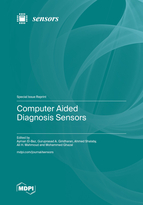Computer Aided Diagnosis Sensors
A special issue of Sensors (ISSN 1424-8220). This special issue belongs to the section "Biomedical Sensors".
Deadline for manuscript submissions: closed (1 July 2022) | Viewed by 140956
Special Issue Editors
Interests: artificial intelligence medical imaging; big data
Special Issues, Collections and Topics in MDPI journals
Interests: Cardiac and vascular mechanics; myocardial recovery; translational research; biomedical device development and sensors
Interests: computer vision; image processing; medical imaging; bioengineering
Special Issues, Collections and Topics in MDPI journals
Interests: Computer vision; image processing; robotics; object detection; tracking; medical imaging; facial biometrics and sensors
Interests: bioimaging; image/video processing; smart systems; machine learning; sensors
Special Issues, Collections and Topics in MDPI journals
Special Issue Information
Dear Colleagues,
Sensors used to diagnose, monitor or treat diseases in the medical domain are known as medical sensors. There are several types of medical sensors that can be utilized for various applications, such as temperature probes, force sensors, pressure sensors, oximeter, electrocardiogram sensors which measure the electrical activity of the heart, heart rate sensors, electroencephalogram sensors that measure the electrical activity of the brain, electromyogram sensors that record electrical activity produced by skeletal muscles, and respiration rate sensors that count how many times the chest rises in a minute. The output of these sensors used to be interpreted by humans, which was time consuming and tedious; however, such interpretations became easy with the advance in artificial intelligence (AI) techniques and the integration of the sensor outputs into computer-aided diagnostic (CAD) systems. This Special Issue will present some of the state-of-the-art AI approaches that are used to diagnose different diseases and disorders based on the data collected from different medical sensors. The ultimate goal is to develop comprehensive and automated computer-aided diagnosis by focusing on the different machine learning algorithms that can be used for this purpose as well as novel applications in the medical field.
Prof. Dr. Ayman El-baz
Prof. Dr. Guruprasad A. Giridharan
Dr. Ahmed Shalaby
Dr. Ali H. Mahmoud
Prof. Dr. Mohammed Ghazal
Guest Editors
Manuscript Submission Information
Manuscripts should be submitted online at www.mdpi.com by registering and logging in to this website. Once you are registered, click here to go to the submission form. Manuscripts can be submitted until the deadline. All submissions that pass pre-check are peer-reviewed. Accepted papers will be published continuously in the journal (as soon as accepted) and will be listed together on the special issue website. Research articles, review articles as well as short communications are invited. For planned papers, a title and short abstract (about 100 words) can be sent to the Editorial Office for announcement on this website.
Submitted manuscripts should not have been published previously, nor be under consideration for publication elsewhere (except conference proceedings papers). All manuscripts are thoroughly refereed through a single-blind peer-review process. A guide for authors and other relevant information for submission of manuscripts is available on the Instructions for Authors page. Sensors is an international peer-reviewed open access semimonthly journal published by MDPI.
Please visit the Instructions for Authors page before submitting a manuscript. The Article Processing Charge (APC) for publication in this open access journal is 2600 CHF (Swiss Francs). Submitted papers should be well formatted and use good English. Authors may use MDPI's English editing service prior to publication or during author revisions.
Keywords
- New technologies for medical applications
- Developing computer-aided diagnosis systems
- Wearable sensors for assessing health
- Machine learning approaches for medical images
- Sensors in medical robotics
- ECG-based CAD systems
- Electromyogram sensor in medical image analysis










